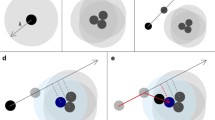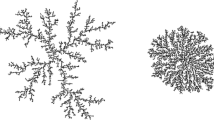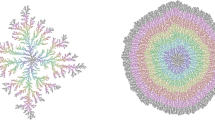Abstract
We distinguish two different types of irreversible aggregation-accretion of individual particles and successive aggregation of clusters of comparable size. In aggregation of particles which follow trajectories of fractal dimensionD 1, we show that physical limits on the aggregation rate impose a lower bound on the fractal dimensionD 0 of the aggregate. Ind-dimensional space,D 0{⩾d−D}1 + 1. Thus aggregation of ballistic particles, withD 1 = 1, is not fractal. By contrast, cluster aggregates appear to attain a finite, limitingD 0 in high dimensions. We present a soluble model with this property, and argue that it should agree with Sutherland's binary aggregation model in high dimensions. For this model,D 0 depends continuously on a parameter; the exponent is not universal.
Similar content being viewed by others
References
A. I. Medalia and F. A. Heckman,J. Colloid Interface Sci. 36:173 (1971).
S. R. Forest and T. A. Witten, Jr.,J. Phys. A. 12:L109 (1979).
D. A. Weitz and M. Olivera,Phys. Rev. Lett. 52:1433 (1984).
T. A. Witten and L. M. Sander,Phys. Rev. Lett. 47:1400 (1981).
P. Meakin,Phys. Rev. Lett. 51:1119 (1983); M. Kolb, R. Botet, and R. Julien,Phys. Rev. Lett. 51:1123 (1983).
B. Mandelbrot,The Fractal Geometry of Nature (W. H. Freeman, San Fransisco, 1982).
P. Meakin,J. Colloid Interface Sci. 96:415 (1983).Phys. Rev. Lett., to be published.
D. Bensimon, E. Domany, and A. Aharony,Phys. Rev. Lett. 51:1394 (1983).
P. Meakin,Phys. Rev. B 29:3722 (1984).
D. N. Sutherland and I. Goodarz-Nia,Chem. Eng. Sci. 26:2071 (1971).
R. C. Ball and T. A. Witten,Phys. Rev. A 29:2966 (1984).
A. B. Harris and T. C. Lubensky,Phys. Rev. B 23:3591 (1981).
T. A. Witten and L. M. Sander,Phys. Rev. B 27:5686 (1983).
J. M. Deutch and P. Meakin,J. Chem. Phys. 78:2093 (1983).
P. Meakin,Phys. Rev. A 27:604 (1983); L. M. Sander, Z. M. Cheng, and R. Richter,Phys. Rev. B 28:6394 (1983).
H. G. E. Hentschel,Phys. Rev. Lett. 52:212 (1984).
A. Kapitulnik, A. Aharony, G. Deutscher, and D. Stauffer,J. Phys. A 16:L269 (1983).
M. Eden, inProceedings of the Fourth Berkeley Symposium on Mathematics, Statistics, and Probability, Berkeley, 1960, Jerzy Neyman, ed. (University of California Press, Berkeley, dy1961), p. 223.
P. Meakin, private communication.
Author information
Authors and Affiliations
Rights and permissions
About this article
Cite this article
Ball, R.C., Witten, T.A. Particle aggregation versus cluster aggregation in high dimensions. J Stat Phys 36, 873–879 (1984). https://doi.org/10.1007/BF01012946
Issue Date:
DOI: https://doi.org/10.1007/BF01012946




